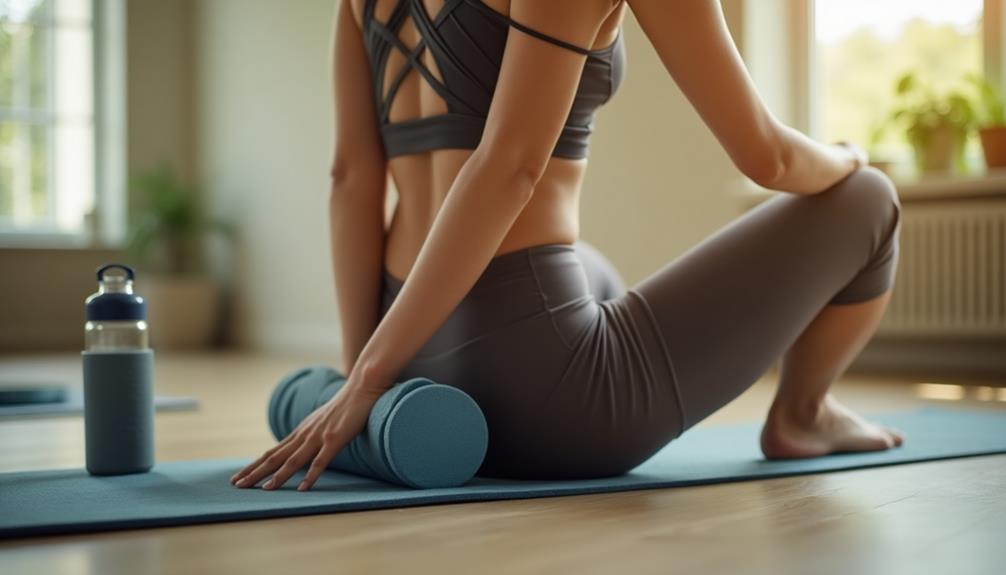To optimize post-workout recovery, start by prioritizing static stretching. Focus on major muscle groups like quadriceps and hamstrings, holding each stretch for 15-60 seconds. Incorporate dynamic movements to keep muscles warm, such as gentle arm circles, for 5-10 minutes. Listen to your body and maintain good posture while stretching; adjust if something feels painful. Deep breathing enhances recovery, so inhale through your nose and exhale through your mouth, consciously relaxing your muscles. Using foam rollers can provide targeted release. Consistency is key for long-term benefits, and there's always more to discover about effective recovery techniques.
Core Insights
- Prioritize static stretching by holding positions for 15 to 60 seconds to enhance flexibility and promote relaxation after workouts.
- Focus on major muscle groups like quadriceps, hamstrings, chest, and shoulders to release tension and improve overall performance.
- Incorporate dynamic movements, such as arm circles, for 5-10 minutes to maintain muscle warmth and increase mobility.
- Hold stretches for at least 15-30 seconds, listening to your body and adjusting to prevent pain and injury.
- Practice deep breathing techniques to enhance oxygen flow and consciously relax muscles during the recovery process.
Prioritize Static Stretching

Static stretching should be a key part of your post-workout routine. It helps improve flexibility and promotes relaxation after intense physical activity. When you stretch statically, you hold a position for a period, usually between 15 to 60 seconds. This allows your muscles to lengthen and recover. To enhance your stretching routine, consider incorporating massage balls for myofascial release, which can help target specific muscle groups and alleviate tension.
After a workout, your muscles are warm and more pliable, making it an ideal time to stretch. Focus on areas that feel tight or fatigued. Remember to breathe deeply and avoid bouncing, as this can lead to injury. Incorporating static stretching into your routine can enhance your overall performance and reduce muscle soreness. Make it a habit, and you'll likely notice improvements in your flexibility and recovery time over time.
Focus on Major Muscle Groups

When stretching after a workout, it's important to target the major muscle groups that have been engaged. This includes your quadriceps, hamstrings, calves, chest, back, and shoulders. By focusing on these areas, you can help release tension and promote flexibility. Using a cooling towel during your stretching routine can enhance comfort and aid in recovery, especially after intense workouts in hot conditions.
Start by holding each stretch for at least 15-30 seconds. For your hamstrings, try a seated forward bend. To stretch your quads, stand on one leg and pull your other foot toward your glutes. Don't forget to stretch your upper body; a simple overhead stretch can work wonders for your shoulders and chest.
Incorporate Dynamic Movements

To enhance your post-workout recovery, incorporating dynamic movements into your stretching routine can be highly beneficial. Unlike static stretches, dynamic movements involve controlled leg and arm swings that help improve flexibility and mobility while keeping your muscles warm. These movements can be particularly effective when combined with compression sleeves for targeted support and enhanced circulation during recovery.
Start with gentle exercises like arm circles or leg swings. These movements prepare your muscles for deeper stretches. You can also include torso twists to engage your core and increase spinal mobility.
Aim for 5-10 minutes of dynamic stretching, focusing on areas you worked during your workout. This approach helps promote blood flow and reduces stiffness, setting the stage for more effective recovery. By integrating these movements, you'll not only feel better but also enhance your overall performance over time.
Hold Stretches for Optimal Duration

Consider the following tips for best stretching:
- Target major muscle groups: Focus on areas like the hamstrings, quadriceps, and shoulders.
- Listen to your body: If a stretch feels painful, ease off slightly.
- Stay consistent: Make stretching a regular part of your routine to see improvements.
- Use proper form: Make sure you're maintaining good posture to avoid injury.
Breathe Deeply and Relax

After holding stretches for an ideal duration, it's important to focus on your breathing and relaxation. Deep breathing enhances oxygen flow, helping your muscles recover more effectively. Inhale slowly through your nose, allowing your abdomen to expand. Hold that breath for a moment, then exhale gently through your mouth.
As you breathe, consciously relax your body. Release any tension in your muscles, letting go of the effort from your workout. This process not only aids recovery but also calms your mind.
Try to maintain a steady rhythm of breath, allowing yourself to settle into a peaceful state. Incorporating deep breathing into your post-stretch routine can greatly improve your recovery and overall well-being.
Use Foam Rollers for Release

- Target specific muscle groups: Focus on areas that feel tight or sore.
- Roll slowly: Move at a steady pace, allowing your muscles to relax.
- Breathe deeply: Inhale and exhale as you roll, promoting relaxation.
- Spend time on knots: Hold pressure on tight spots for 20-30 seconds.
Stay Consistent With Your Routine

Here's a quick table to guide your routine:
| Stretch Type | Duration |
|---|---|
| Hamstring Stretch | 30 seconds |
| Quadriceps Stretch | 30 seconds |
| Shoulder Stretch | 30 seconds |
| Calf Stretch | 30 seconds |
| Hip Flexor Stretch | 30 seconds |
Incorporating these stretches regularly will enhance your flexibility, reduce muscle soreness, and keep you ready for your next workout. Remember, consistency is key!
Frequently Asked Questions
Can Stretching Help Prevent Injuries During Workouts?
Imagine you're running a marathon and pull a muscle. Stretching beforehand can enhance flexibility, reducing injury risk. By incorporating regular stretching into your routine, you'll improve your range of motion and stay injury-free during workouts.
How Often Should I Stretch Each Week?
You should stretch at least three to four times a week for maximum benefits. Consistency helps improve flexibility and reduces muscle tightness. Listen to your body and adjust based on your activity level and needs.
Is It Safe to Stretch Before a Workout?
Imagine a tree bending gracefully in the wind. Stretching before a workout can be safe, but it's wise to warm up first. You'll prepare your body, enhancing flexibility and reducing injury risk during your exercise journey.
What Are the Benefits of Stretching for Flexibility?
Stretching improves your flexibility by lengthening muscles and increasing range of motion. It helps prevent injuries, enhances athletic performance, and promotes better posture. You'll feel more agile and ready for your next physical challenge.
Can I Stretch if I'm Sore From a Workout?
Yes, you can stretch if you're sore from a workout. Gentle stretching helps increase blood flow, alleviates tightness, and improves flexibility. Just listen to your body, and don't push through any sharp pain.

